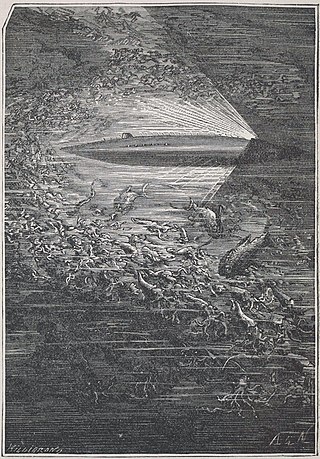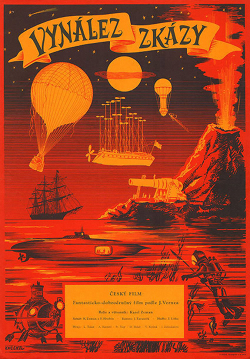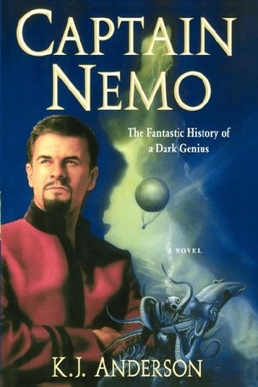
Jules Gabriel Verne was a French novelist, poet, and playwright. His collaboration with the publisher Pierre-Jules Hetzel led to the creation of the Voyages extraordinaires, a series of bestselling adventure novels including Journey to the Center of the Earth (1864), Twenty Thousand Leagues Under the Seas (1870), and Around the World in Eighty Days (1872). His novels, always well documented, are generally set in the second half of the 19th century, taking into account the technological advances of the time.

Nautilus is the fictional submarine belonging to Captain Nemo featured in Jules Verne's novels Twenty Thousand Leagues Under the Seas (1870) and The Mysterious Island (1875). Verne named the Nautilus after Robert Fulton's real-life submarine Nautilus (1800). For the design of the Nautilus, Verne was inspired by the French Navy submarine Plongeur, a model of which he had seen at the 1867 Exposition Universelle, three years before writing his novel.

Captain Nemo is a character created by the French novelist Jules Verne (1828–1905). Nemo appears in two of Verne's science-fiction books, Twenty Thousand Leagues Under the Seas (1870) and The Mysterious Island (1875). He also makes a brief appearance in a play written by Verne with the collaboration of Adolphe d'Ennery, Journey Through the Impossible (1882).

From the Earth to the Moon: A Direct Route in 97 Hours, 20 Minutes is an 1865 novel by Jules Verne. It tells the story of the Baltimore Gun Club, a post-American Civil War society of weapons enthusiasts, and their attempts to build an enormous Columbiad space gun and launch three people — the Gun Club's president, his Philadelphian armor-making rival, and a French poet — in a projectile with the goal of a Moon landing. Five years later, Verne wrote a sequel called Around the Moon.

Star Trek: The Motion Picture is a 1979 American science fiction film directed by Robert Wise. The Motion Picture is based on and stars the cast of the 1966–1969 television series Star Trek created by Gene Roddenberry, who serves as producer. In the film, set in the 2270s, a mysterious and powerful alien cloud known as V'Ger approaches Earth, destroying everything in its path. Admiral James T. Kirk assumes command of the recently refitted Starship Enterprise to lead it on a mission to determine V'Ger's origins and save the planet.

The submarine film is a subgenre of war film in which the majority of the plot revolves around a submarine below the ocean's surface. Films of this subgenre typically focus on a small but determined crew of submariners battling against enemy submarines or submarine-hunter ships, or against other problems ranging from disputes amongst the crew, threats of mutiny, life-threatening mechanical breakdowns, or the daily difficulties of living on a submarine.

The Mysterious Island is a novel by Jules Verne, published in 1875. The first edition, published by Hetzel, contains illustrations by Jules Férat. The novel is a crossover sequel to Verne's famous Twenty Thousand Leagues Under the Seas (1870) and In Search of the Castaways (1867–68), though its themes are vastly different from those books. An early draft of the novel, rejected by Verne's publisher and wholly reconceived before publication, was titled Shipwrecked Family: Marooned with Uncle Robinson, indicating the influence of the novels Robinson Crusoe and The Swiss Family Robinson. Verne developed a similar theme in his novel, Godfrey Morgan.
An albatross is one of a family of large winged seabirds.

Robur the Conqueror is a science fiction novel by Jules Verne, published in 1886. It is also known as The Clipper of the Clouds. It has a sequel, Master of the World, which was published in 1904.

Master of the World, published in 1904, is one of the last novels by French pioneer science fiction writer, Jules Verne. At the time Verne wrote the novel, his health was failing. Master of the World is a "black novel," filled with foreboding and fear of the rise of tyrants such as the novel's villain, Robur, and totalitarianism. Master of the World contains a number of scientific ideas, current to Verne's time, which are now widely known to be errors. For example, traveling at high speed does not reduce a vehicle's weight.

Return of the Fly is a 1959 American horror science-fiction film and sequel to The Fly (1958). It is the second installment in The Fly film series. It was released in 1959 as a double feature with The Alligator People. It was directed by Edward Bernds. Unlike the previous film, Return of the Fly was shot in black and white.

Two Years' Vacation is an adventure novel by Jules Verne, published in 1888. The story tells of the fortunes of a group of schoolboys stranded on a deserted island in the South Pacific, and of their struggles to overcome adversity. In his preface to the book, Verne explains that his goals were to create a Robinson Crusoe-like environment for children, and to show the world what the intelligence and bravery of a child were capable of when put to the test.

Mysterious Island is a 1961 science fiction adventure film about prisoners in the American Civil War who escape in a balloon and then find themselves stranded on a remote island populated by giant and tiny animals.

Facing the Flag or For the Flag is an 1896 patriotic novel by Jules Verne. The book is part of the Voyages extraordinaires series.

HMS Sword is a fictional experimental submarine of the British Royal Navy in Jules Verne's 1896 novel Facing the Flag.

Invention for Destruction is a 1958 Czechoslovak black-and-white science fiction adventure film, directed by Karel Zeman, produced by Zdeněk Novák, and starring Lubor Tokoš, Arnošt Navrátil, and Miloslav Holub. Based on several works by Jules Verne, primarily his 1896 novel Facing the Flag, the film evokes the original illustrations for Verne's works by combining live actors with various forms of animation.

Captain Nemo: The Fantastic History of a Dark Genius is a novel by Kevin J. Anderson, published in 2002 by Pocket Books. It is a secret history and crossover work, the central premise being that many of the things Jules Verne wrote about existed in real life as told to him by the real Captain Nemo.

Alfred N. Zimbalist was a producer of low-budget films such as Robot Monster, Monster from Green Hell, Cat-Women of the Moon, Watusi and Baby Face Nelson.
Valley of the Dragons is a black and white 1961 American science fiction film loosely based on Jules Verne's Off on a Comet and heavily dependent on stock footage from the movies One Million B.C., King Dinosaur, Cat-Women of the Moon and Rodan. Director Edward Bernds says the film was built around stock footage from One Million B.C.
Jules Verne's 1870 novel Twenty Thousand Leagues Under the Sea has been adapted and referenced in popular culture on numerous occasions.

















